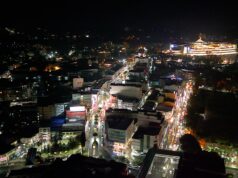SOMETIME IN the immediate aftermath of the Mount Pinatubo eruptions, Aweca Agro Forest entered into an Industrial Forest Management Agreement (IFMA) with the Department of the Environment and Natural Resources to regreen the ash-covered hinterlands of Capas and San Jose towns in Tarlac.
The agreement covered some 5,000 hectares which were to be planted with forest and fruit-bearing trees, with the former specifically marked for harvesting as timber once grown to maturity. A total of 2,810 hectares in the area now teems with fully grown gmelina, acacia, lauan, mangoes and other species as well as the rattan vine.
The IFMA with Aweca has not only restored the greenery in the area but raised the quality of life of the indigenous people there.
”Hindi lamang panibagong buhay ang hatid sa aming mga katutubo ng Aweca, kundi maaliwalas na pamumuhay,” said Kennedy Molina of the Tribal Affairs Office in Capas.
Molina very well remembers the hegira of the tribes from the fury of the volcano which buried their upland farms, homes and beasts of burden. Leaving them to fend for themselves in the confines of evacuation centers, at the mercy, if not the charity of government, NGOs and other do-gooders.
With the IFMA, the tribes returned to their old habitat, provided with regular sources of income by Aweca as stewards of the industrial forest areas. Extra income came from the banana plants that thrived in the area, which fruits and “heart” they transported to the lowlands to sell.
Narrow, dangerous mountain trails gave way to a 20-kilometer access road Aweca constructed which facilitated both the transport of goods as well as services to the 16 sitios in Sta. Juliana, four in Bueno, two in O’Donell, five in Maruglong and one in Kalangitan within the IFMA area.
Says Molina: “Dati-rati, isinasakay ng mga katutubo sa karetang hila ng kalabaw ang kanilang ani para maibaba sa bayan. Ngayon, puwede nang iakyat ang mga sasakyan sa bundok para diretsong makuha ng mga mamimili ang mga produkto.”
One other road to a better life for the tribes that they said they owed Aweca is the provision of scholarships to their children and the company’s hiring of a full-time teacher for adult education right in the uplands.
“Marami talagang nagawa ang Aweca para sa amin. Nandiyan din ang mga poso ng tubig, ang mga medical mission, ang libreng gamot pati na ang paggamit ng kanilang mga sasakyan sa oras ng emergency. Marami sa mga katutubo ang nagkasakuna sa bundok at maaring namatay kundi mabilis na naibaba sa hospital sa bayan dala ng mga sasakyan ng Aweca,” Molina testified.
He furthered: “Malaking benepisyo sa kanila ang Aweca dahil nagkaroon sila ng pag-asang mamuhay ng may kaginhawaan.” This, as he cited tribal families who are now proud owners of motorcycles, sari-sari stores and television sets.
And, as if reminded of the intent of the IFMA, he hastened: “Maganda ang proyektong ipinatupad ng Aweca. Bukod sa gumanda ang pamumuhay ng mga katutubo, naging luntian pa ang dating nakakalbong kabundukan at nakatulong sa pangangalaga sa kalikasan.”
All’s well that ends well there? Not quite.
Just at the perfect time for the fully-grown “plantation trees” to be harvested by Aweca, came Executive Order 23 which banned the cutting of trees for timber.
Question that Aweca would not dare ask the government: Where does that leave its IFMA with the DENR signed almost 20 years ago?
It has been two months now, and not on piece of timber has gone down from the Aweca area.
It has been two months now and the indigenous people are restive.
Says Barangay Chairman Salvador de los Reyes: “Labis na naapektuhan ang mga katutubo dahil nawalan sila ng hanapbuhay at lubos silang nagtaka kung bakit naisama ang Aweca bagama’t wala naman silang nilalabag na kautusan sa pagpuputol ng kahoy.”
Anybody out there – DENR, National Commission on Indigenous Peoples, Office of the President – listening?
The agreement covered some 5,000 hectares which were to be planted with forest and fruit-bearing trees, with the former specifically marked for harvesting as timber once grown to maturity. A total of 2,810 hectares in the area now teems with fully grown gmelina, acacia, lauan, mangoes and other species as well as the rattan vine.
The IFMA with Aweca has not only restored the greenery in the area but raised the quality of life of the indigenous people there.
”Hindi lamang panibagong buhay ang hatid sa aming mga katutubo ng Aweca, kundi maaliwalas na pamumuhay,” said Kennedy Molina of the Tribal Affairs Office in Capas.
Molina very well remembers the hegira of the tribes from the fury of the volcano which buried their upland farms, homes and beasts of burden. Leaving them to fend for themselves in the confines of evacuation centers, at the mercy, if not the charity of government, NGOs and other do-gooders.
With the IFMA, the tribes returned to their old habitat, provided with regular sources of income by Aweca as stewards of the industrial forest areas. Extra income came from the banana plants that thrived in the area, which fruits and “heart” they transported to the lowlands to sell.
Narrow, dangerous mountain trails gave way to a 20-kilometer access road Aweca constructed which facilitated both the transport of goods as well as services to the 16 sitios in Sta. Juliana, four in Bueno, two in O’Donell, five in Maruglong and one in Kalangitan within the IFMA area.
Says Molina: “Dati-rati, isinasakay ng mga katutubo sa karetang hila ng kalabaw ang kanilang ani para maibaba sa bayan. Ngayon, puwede nang iakyat ang mga sasakyan sa bundok para diretsong makuha ng mga mamimili ang mga produkto.”
One other road to a better life for the tribes that they said they owed Aweca is the provision of scholarships to their children and the company’s hiring of a full-time teacher for adult education right in the uplands.
“Marami talagang nagawa ang Aweca para sa amin. Nandiyan din ang mga poso ng tubig, ang mga medical mission, ang libreng gamot pati na ang paggamit ng kanilang mga sasakyan sa oras ng emergency. Marami sa mga katutubo ang nagkasakuna sa bundok at maaring namatay kundi mabilis na naibaba sa hospital sa bayan dala ng mga sasakyan ng Aweca,” Molina testified.
He furthered: “Malaking benepisyo sa kanila ang Aweca dahil nagkaroon sila ng pag-asang mamuhay ng may kaginhawaan.” This, as he cited tribal families who are now proud owners of motorcycles, sari-sari stores and television sets.
And, as if reminded of the intent of the IFMA, he hastened: “Maganda ang proyektong ipinatupad ng Aweca. Bukod sa gumanda ang pamumuhay ng mga katutubo, naging luntian pa ang dating nakakalbong kabundukan at nakatulong sa pangangalaga sa kalikasan.”
All’s well that ends well there? Not quite.
Just at the perfect time for the fully-grown “plantation trees” to be harvested by Aweca, came Executive Order 23 which banned the cutting of trees for timber.
Question that Aweca would not dare ask the government: Where does that leave its IFMA with the DENR signed almost 20 years ago?
It has been two months now, and not on piece of timber has gone down from the Aweca area.
It has been two months now and the indigenous people are restive.
Says Barangay Chairman Salvador de los Reyes: “Labis na naapektuhan ang mga katutubo dahil nawalan sila ng hanapbuhay at lubos silang nagtaka kung bakit naisama ang Aweca bagama’t wala naman silang nilalabag na kautusan sa pagpuputol ng kahoy.”
Anybody out there – DENR, National Commission on Indigenous Peoples, Office of the President – listening?



